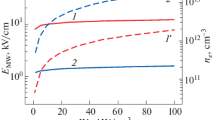Abstract
The experimentally observed growth of the plasma density in a high-current high-voltage pulsed discharge in a liquid medium is compared with the results of calculations based on the effective cross sections for electron-impact ionization and other elementary processes. It is found that, in the initial stage of the discharge, the plasma density grows linearly with time, whereas at densities above 3 × 1010 cm−3, the growth becomes exponential due to the collective acceleration of plasma electrons. The gas-vapor fraction of the water medium is ionized by two groups of electrons: low-energy electrons, with energies about several tens of electronvolts, and high-energy ones, with energies in the kiloelectronvolt range. The energy spent on water ionization is estimated and is found to be several times higher than the energy required to ionize a rarefied gas.
Similar content being viewed by others
References
V. Ya. Ushakov, Pulsed Electric Breakdown of Liquids (TGU, Tomsk, 1975) [in Russian].
J. B. Hasted, Physics of Atomic Collisions (Butterworths, London, 1964; Mir, Moscow, 1965).
Encyclopedia of Low-Temperature Plasma, Ed. by V. E. Fortov (Nauka, Moscow, 2000), Vol. 1 [in Russian].
E. I. Skibenko, V. B. Yuferov, I. V. Buravilov, and A. N. Ponomarev, Zh. Tekh. Fiz. 76(9), 133 (2006) [Tech. Phys. 51, 1240 (2006)].
L. A. Yutkin, Electrohydraulic Effect and Its Industrial Applications (Mashinostroenie, Leningrad, 1986) [in Russian].
C. F. Barnett, J. A. Ray, E. Ricci, et al., Atomic Data for Controlled Fusion Research (Oak Ridge National Lab., 1977).
Ya. B. Fainnberg, At. Energ. 11, 313 (1961).
I. F. Kharchenko, Ya. B. Fainnberg, R. M. Nikolaev, et al., Yad. Sintez (Dopolnenie) 3, 1101 (1962).
E. A. Lysenko, E. I. Skibenko, and V. B. Yuferov, Influence of Vacuum Conditions on the Entry of Light Impurities into a Plasma at the Early Stage of Discharge (TsNII Atominform, Moscow, 1987) [in Russian].
Author information
Authors and Affiliations
Additional information
Original Russian Text © E.I. Skibenko, V.B. Yuferov, I.V. Buravilov, A.N. Ponomarev, 2007, published in Zhurnal Tekhnicheskoĭ Fiziki, 2007, Vol. 77, No. 5, pp. 19–22.
Rights and permissions
About this article
Cite this article
Skibenko, E.I., Yuferov, V.B., Buravilov, I.V. et al. Rates and channels of water ionization by a high-current high-voltage pulsed discharge. Tech. Phys. 52, 555–558 (2007). https://doi.org/10.1134/S1063784207050039
Received:
Issue Date:
DOI: https://doi.org/10.1134/S1063784207050039




